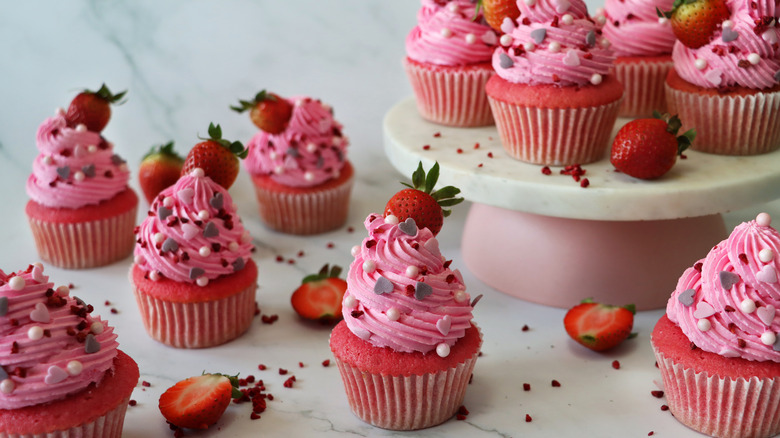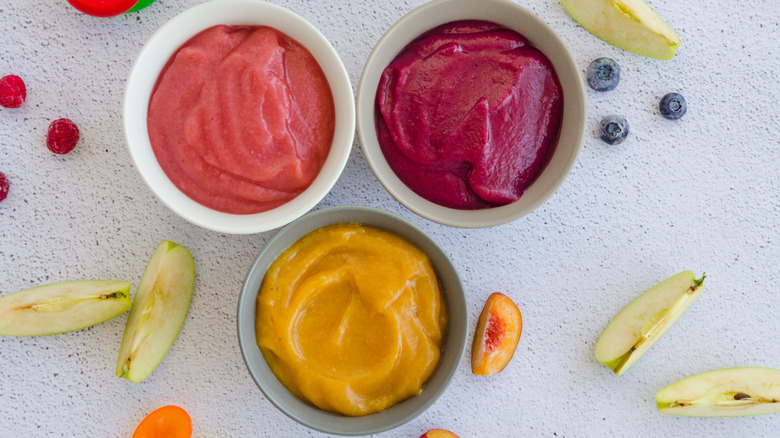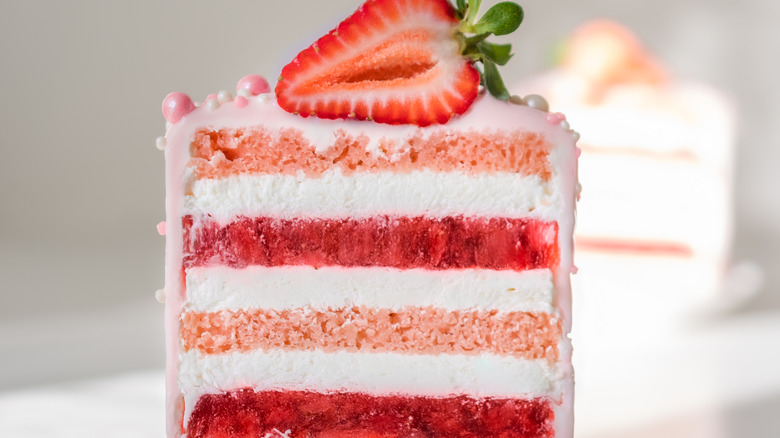Why Fruit Puree Can Help Achieve An Incredibly Tender Cake
Cake: It's one of humankind's most stellar creations. Whether it's rich, decadent devil's food, or a light and airy angel version; something spectacularly tall and layered, or a single-serve cupcake; paired with frosting or simply as is out of the oven, there are so many ways to eat cake. And perhaps one of the most exciting ways to enjoy a slice is when your favorite fruit gets involved. It might be lemon, pineapple, or a berry like strawberry or blackberry, but no matter what, these punchy natural gems bring concentrated flavor power.
But adding fruit to your cake in the form of a puree may actually be functional as well as delicious. The beauty of fruit puree is that it pulls double duty, bringing major flavor, plus a necessary element that we may not even consider when baking cake: acidity.
It may seem surprising for a sweet dessert, but acid is critical to creating the tender crumb we love in our cake, no matter the inspiration. Gluten, a protein present in cake thanks to flour, can develop into long chains and while that may be desirable in other cases (like some breads), when it comes to cake, those strands add up to toughness. Enter acid, which works against the development of that network, resulting in smaller strands, thus a softer texture. Acid also works in tandem with leavening agents like baking soda, which provides lift, and an airier cake is also a softer, more cloud-like experience.
The science of this fruity secret
There are a number of sources that can supply that all-important acidity here. Typically, it is a result of buttermilk or vinegar, chocolate, brown sugar (which also qualifies as an acidic ingredient, believe it or not), as well as coffee or espresso, or citrus like lemon or orange. Fruit puree also tends to be lower on the pH scale, which makes it a strong provider of that acid boost in baking.
It's a bit more complex than simply adding in a scoop of the stuff, though. The trouble is, fruit purees contain a lot of liquid, and given that cake batters are already composed of a high percentage of "wet" ingredients, adding puree can make the moisture meter go haywire. It's true that moistness is usually a desirable quality in a cake, but only to a certain degree. If it's too wet, it can wind up falling apart or tasting underbaked, so if you want a fruit-based cake with a big fruity flavor, you'll need to substitute some (or all) of the liquid in your batter with fruit puree. Given that each fruit will have a different level of water activity (the amount of natural moisture), and that may further fluctuate with ripeness or time of year, this means it may take some experimenting to find the perfect ratio, but the finished product will be worth it with every bite.
Fruity cake inspiration
Armed with the scientific know-how for a perfectly tender and fruit-forward cake, it's easy to get creative. Inspiration is everywhere, and changing all the time thanks to seasonality.
If you're planning to make your own puree, the sky's the limit, and you can mix and match to your heart's desire with combos like strawberry banana, lemon raspberry, or pineapple lime. But if you aren't up for pureeing fresh fruit, you can purchase one from your favorite grocer — either fresh or frozen — or even add a jar of baby food to your cake batter, which won't bring a ton of extra sugar or other additives to the mix. Baby food also comes in combined vegetable flavors like carrot-pear, which may spark a few ideas.
Adding fresh herbs to your cake can compliment the natural sweetness of the fruit: Mint, basil, and rosemary all work well with everything from berries to bananas. You can also reach for a flavored topping like cream cheese frosting or sour cream chocolate frosting to add a little extra wow. But a tender, fruity cake is bursting with flavor already, so anything you add is just the icing on top.


